+ Open data
Open data
- Basic information
Basic information
| Entry | Database: PDB / ID: 5vvl | ||||||
|---|---|---|---|---|---|---|---|
| Title | Cas1-Cas2 bound to full-site mimic with Ni | ||||||
 Components Components |
| ||||||
 Keywords Keywords | HYDROLASE/DNA / Complex / DNA / HYDROLASE-DNA complex | ||||||
| Function / homology |  Function and homology information Function and homology informationCRISPR-cas system / crossover junction DNA endonuclease activity / 5'-flap endonuclease activity / maintenance of CRISPR repeat elements / defense response to virus / endonuclease activity / Hydrolases; Acting on ester bonds / DNA repair / DNA damage response / protein homodimerization activity ...CRISPR-cas system / crossover junction DNA endonuclease activity / 5'-flap endonuclease activity / maintenance of CRISPR repeat elements / defense response to virus / endonuclease activity / Hydrolases; Acting on ester bonds / DNA repair / DNA damage response / protein homodimerization activity / DNA binding / identical protein binding / metal ion binding / cytoplasm Similarity search - Function | ||||||
| Biological species |  synthetic construct (others) | ||||||
| Method |  X-RAY DIFFRACTION / X-RAY DIFFRACTION /  SYNCHROTRON / SYNCHROTRON /  MOLECULAR REPLACEMENT / MOLECULAR REPLACEMENT /  molecular replacement / Resolution: 3.31 Å molecular replacement / Resolution: 3.31 Å | ||||||
 Authors Authors | Wright, A.V. / Knott, G.J. / Doxzen, K.D. / Doudna, J.A. | ||||||
| Funding support |  United States, 1items United States, 1items
| ||||||
 Citation Citation |  Journal: Science / Year: 2017 Journal: Science / Year: 2017Title: Structures of the CRISPR genome integration complex. Authors: Addison V Wright / Jun-Jie Liu / Gavin J Knott / Kevin W Doxzen / Eva Nogales / Jennifer A Doudna /  Abstract: CRISPR-Cas systems depend on the Cas1-Cas2 integrase to capture and integrate short foreign DNA fragments into the CRISPR locus, enabling adaptation to new viruses. We present crystal structures of ...CRISPR-Cas systems depend on the Cas1-Cas2 integrase to capture and integrate short foreign DNA fragments into the CRISPR locus, enabling adaptation to new viruses. We present crystal structures of Cas1-Cas2 bound to both donor and target DNA in intermediate and product integration complexes, as well as a cryo-electron microscopy structure of the full CRISPR locus integration complex, including the accessory protein IHF (integration host factor). The structures show unexpectedly that indirect sequence recognition dictates integration site selection by favoring deformation of the repeat and the flanking sequences. IHF binding bends the DNA sharply, bringing an upstream recognition motif into contact with Cas1 to increase both the specificity and efficiency of integration. These results explain how the Cas1-Cas2 CRISPR integrase recognizes a sequence-dependent DNA structure to ensure site-selective CRISPR array expansion during the initial step of bacterial adaptive immunity. | ||||||
| History |
|
- Structure visualization
Structure visualization
| Structure viewer | Molecule:  Molmil Molmil Jmol/JSmol Jmol/JSmol |
|---|
- Downloads & links
Downloads & links
- Download
Download
| PDBx/mmCIF format |  5vvl.cif.gz 5vvl.cif.gz | 593.2 KB | Display |  PDBx/mmCIF format PDBx/mmCIF format |
|---|---|---|---|---|
| PDB format |  pdb5vvl.ent.gz pdb5vvl.ent.gz | 484.7 KB | Display |  PDB format PDB format |
| PDBx/mmJSON format |  5vvl.json.gz 5vvl.json.gz | Tree view |  PDBx/mmJSON format PDBx/mmJSON format | |
| Others |  Other downloads Other downloads |
-Validation report
| Summary document |  5vvl_validation.pdf.gz 5vvl_validation.pdf.gz | 506.5 KB | Display |  wwPDB validaton report wwPDB validaton report |
|---|---|---|---|---|
| Full document |  5vvl_full_validation.pdf.gz 5vvl_full_validation.pdf.gz | 520.6 KB | Display | |
| Data in XML |  5vvl_validation.xml.gz 5vvl_validation.xml.gz | 45.4 KB | Display | |
| Data in CIF |  5vvl_validation.cif.gz 5vvl_validation.cif.gz | 62 KB | Display | |
| Arichive directory |  https://data.pdbj.org/pub/pdb/validation_reports/vv/5vvl https://data.pdbj.org/pub/pdb/validation_reports/vv/5vvl ftp://data.pdbj.org/pub/pdb/validation_reports/vv/5vvl ftp://data.pdbj.org/pub/pdb/validation_reports/vv/5vvl | HTTPS FTP |
-Related structure data
| Related structure data |  8827C 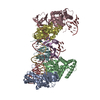 5vvjC 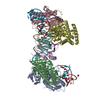 5vvkC 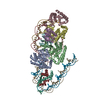 5wfeC  5ds5S S: Starting model for refinement C: citing same article ( |
|---|---|
| Similar structure data |
- Links
Links
- Assembly
Assembly
| Deposited unit | 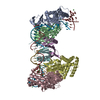
| ||||||||
|---|---|---|---|---|---|---|---|---|---|
| 1 |
| ||||||||
| Unit cell |
|
- Components
Components
-CRISPR-associated ... , 2 types, 6 molecules ABCDEF
| #1: Protein | Mass: 33570.770 Da / Num. of mol.: 4 Source method: isolated from a genetically manipulated source Source: (gene. exp.)  Strain: K12 / Gene: ygbT, cas1, b2755, JW2725 / Variant: MG1655 / Production host:  References: UniProt: Q46896, Hydrolases; Acting on ester bonds #2: Protein | Mass: 11553.270 Da / Num. of mol.: 2 Source method: isolated from a genetically manipulated source Source: (gene. exp.)  Strain: K12 / Gene: ygbF, cas2, b2754, JW5438 / Variant: MG1655 / Production host:  References: UniProt: P45956, Hydrolases; Acting on ester bonds |
|---|
-DNA chain , 4 types, 4 molecules GHJK
| #3: DNA chain | Mass: 3319.175 Da / Num. of mol.: 1 / Source method: obtained synthetically / Source: (synth.) synthetic construct (others) |
|---|---|
| #4: DNA chain | Mass: 3343.200 Da / Num. of mol.: 1 / Source method: obtained synthetically / Source: (synth.) synthetic construct (others) |
| #5: DNA chain | Mass: 17907.432 Da / Num. of mol.: 1 / Source method: obtained synthetically / Source: (synth.) synthetic construct (others) |
| #6: DNA chain | Mass: 17967.461 Da / Num. of mol.: 1 / Source method: obtained synthetically / Source: (synth.) synthetic construct (others) |
-Non-polymers , 1 types, 22 molecules 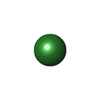
| #7: Chemical | ChemComp-NI / |
|---|
-Experimental details
-Experiment
| Experiment | Method:  X-RAY DIFFRACTION / Number of used crystals: 1 X-RAY DIFFRACTION / Number of used crystals: 1 |
|---|
- Sample preparation
Sample preparation
| Crystal | Density Matthews: 3.33 Å3/Da / Density % sol: 63.08 % |
|---|---|
| Crystal grow | Temperature: 281 K / Method: vapor diffusion, hanging drop / pH: 6.4 Details: 100 mM MES pH 6.4, 20% (w/v) PEG MME 2000, 0.2 M NaCl, 3 mM NiCl2 |
-Data collection
| Diffraction | Mean temperature: 80 K | |||||||||||||||||||||
|---|---|---|---|---|---|---|---|---|---|---|---|---|---|---|---|---|---|---|---|---|---|---|
| Diffraction source | Source:  SYNCHROTRON / Site: SYNCHROTRON / Site:  SSRL SSRL  / Beamline: BL9-2 / Wavelength: 0.9795 Å / Beamline: BL9-2 / Wavelength: 0.9795 Å | |||||||||||||||||||||
| Detector | Type: DECTRIS PILATUS3 6M / Detector: PIXEL / Date: Mar 4, 2017 | |||||||||||||||||||||
| Radiation | Protocol: SINGLE WAVELENGTH / Monochromatic (M) / Laue (L): M / Scattering type: x-ray | |||||||||||||||||||||
| Radiation wavelength | Wavelength: 0.9795 Å / Relative weight: 1 | |||||||||||||||||||||
| Reflection | Resolution: 2.96→39.55 Å / Num. obs: 47810 / % possible obs: 96.3 % / Redundancy: 6.9 % / Biso Wilson estimate: 92.52 Å2 / CC1/2: 0.996 / Rmerge(I) obs: 0.203 / Rpim(I) all: 0.083 / Rrim(I) all: 0.22 / Net I/σ(I): 7.9 / Num. measured all: 329343 / Scaling rejects: 0 | |||||||||||||||||||||
| Reflection shell | Diffraction-ID: 1
|
-Phasing
| Phasing | Method:  molecular replacement molecular replacement |
|---|
- Processing
Processing
| Software |
| ||||||||||||||||||||||||||||||||||||||||||||||||||||||||||||||||||||||||||||||||||||||||||||||||||
|---|---|---|---|---|---|---|---|---|---|---|---|---|---|---|---|---|---|---|---|---|---|---|---|---|---|---|---|---|---|---|---|---|---|---|---|---|---|---|---|---|---|---|---|---|---|---|---|---|---|---|---|---|---|---|---|---|---|---|---|---|---|---|---|---|---|---|---|---|---|---|---|---|---|---|---|---|---|---|---|---|---|---|---|---|---|---|---|---|---|---|---|---|---|---|---|---|---|---|---|
| Refinement | Method to determine structure:  MOLECULAR REPLACEMENT MOLECULAR REPLACEMENTStarting model: 5DS5 Resolution: 3.31→39.504 Å / SU ML: 0.47 / Cross valid method: FREE R-VALUE / σ(F): 1.33 / Phase error: 28.46
| ||||||||||||||||||||||||||||||||||||||||||||||||||||||||||||||||||||||||||||||||||||||||||||||||||
| Solvent computation | Shrinkage radii: 0.9 Å / VDW probe radii: 1.11 Å | ||||||||||||||||||||||||||||||||||||||||||||||||||||||||||||||||||||||||||||||||||||||||||||||||||
| Displacement parameters | Biso max: 328.62 Å2 / Biso mean: 106.5272 Å2 / Biso min: 46.84 Å2 | ||||||||||||||||||||||||||||||||||||||||||||||||||||||||||||||||||||||||||||||||||||||||||||||||||
| Refinement step | Cycle: final / Resolution: 3.31→39.504 Å
| ||||||||||||||||||||||||||||||||||||||||||||||||||||||||||||||||||||||||||||||||||||||||||||||||||
| Refine LS restraints |
| ||||||||||||||||||||||||||||||||||||||||||||||||||||||||||||||||||||||||||||||||||||||||||||||||||
| LS refinement shell | Refine-ID: X-RAY DIFFRACTION / Rfactor Rfree error: 0 / Total num. of bins used: 13
|
 Movie
Movie Controller
Controller





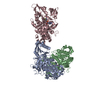

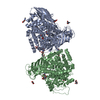
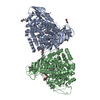




 PDBj
PDBj







































